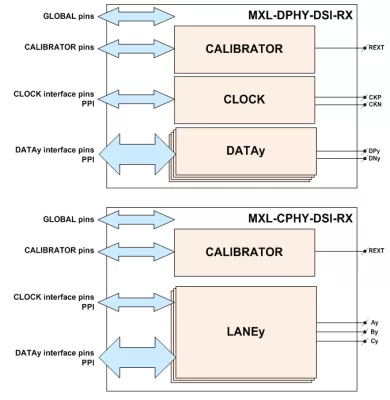The MXL-CPHY-DPHY-DSI-RX is a high-frequency low-power, low-cost, source-synchronous, physical Layer. The PHY is configured as MIPI Slave supporting camera interface CSI-2 v1.2 and display interface DSI v1.3 applications in the D-PHY mode. It also supports camera interface CSI-2 v1.3 and display interface DSI-C v1.0 applications in the C-PHY mode. The High-Speed signals have a low voltage swing, while Low-Power signals have large swing. High-Speed functions are used for High-Speed data traffic while low power functions are mostly used for control.
The C-PHY is based on 3-Phase symbol encoding technology delivering 2.28 bits per symbol over three-wire trios, operating with a symbol rate range of 80 to 2500 Msps per lane, which is the equivalent of about 182.8 to 5714 Mbps per lane.
The D-PHY supports a bit rate range of 80 to 1500 Mbps per Lane without deskew calibration and up to 2500 Mbps with deskew calibration.
The low-power mode and escape mode are the same in both the D-PHY and C-PHY modes. To minimize EMI, the drivers for low-power mode are slew-rate controlled and current limited. The maximum data rate in low-power mode is 10 Mbps. For a fixed clock frequency, the available data capacity of a PHY configuration can be increased by using more lanes. Effective data throughput can be reduced by employing burst mode communication.
MIPI C-PHY/D-PHY Combo DSI RX (Receiver) IP in TSMC 28HPC+
Overview
Key Features
- Dual mode PHY can support C-PHY and D-PHY
- Supports MIPI® Specification for D-PHY Version 1.2.
- Supports MIPI® Specification for C-PHY Version 1.0.
- Four Lane in D-PHY mode.
- Three Lane in C-PHY mode.
- Supports both high speed and low-power modes.
- 80 Mbps to 1.5 Gbps data rate per lane in D-PHY mode without Deskew calibration.
- Up to 2.5 Gbps data rate per lane in D-PHY mode with Deskew calibration.
- 80 Msps to 2.5 Gsps symbol rate per lane in C-PHY high speed mode.
- Equivalent to 182.8 Mbps to 5.714 Gbps per lane in C-PHY high speed mode.
- 10 Mbps data rate in low-power mode.
- Low power dissipation.
- Loopback testability support.
- Optional resistance termination calibrator.
- Deskew calibration support in D-PHY.
Benefits
- Compatible with both C-PHY 1.0 and D-PHY 1.2 specifications for added flexibility
Block Diagram

Applications
- Mobile
- Displays
- IoT
- VR/AR/MR
- Consumer electronics
- Automotive
Deliverables
- Specifications
- GDSII
- LVS netlist
- LEF file
- IBIS Model
- Verilog Model
- Timing Model
- Integration Guidelines
- RTL
- Documentation
- One year support
Technical Specifications
Foundry, Node
TSMC, 28nm HPC+
Maturity
Silicon Proven
Availability
Now
TSMC
Silicon Proven:
28nm
HPCP